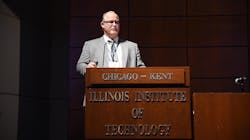FRA highlights initiatives to curb trespassing incidents and intentional deaths by rail
The Federal Railroad Administration (FRA) has been working on initiatives to address the number of trespassing incidents and intentional deaths by rail through funding opportunities, testing new detection and deterrent systems and creating summits to engage local stakeholders.
James Payne, staff director for FRA’s Highway-Rail Crossing and Trespass Programs Division, provided attendees of Metra’s Oct. 4 event, “Breaking the Silence: Restoring Hope, Savings Lives” an update of the administration’s efforts to increase rail safety.
According to FRA data, there were 536 fatalities in 2018 from trespassing excluding highway-rail incidents. Additionally, there were 261 suicides reported in 2018. This number is lower compared to the past three years where 2015 and 2016 each had 318 suicide fatalities and 2017 had 273 suicide fatalities.
To address these incidents, FRA has developed a national strategy with four areas of focus:
Data gathering and analysis: FRA will examine data to determine why people are trespassing.
Community engagement: FRA will conduct site visits to hot spots for trespassing to determine why these areas are being impacted.
Funding: FRA will continue funding the Consolidated Rail Infrastructure and Safety Improvements Infrastructure Grant Program to continue updating rail infrastructure for a safer system.
Partnerships with stakeholders: FRA will soon be announcing a Notice of Funding Opportunity grant of $100,000 to partner with a railroad or nonprofit to create a suicide prevention program. This first-of-its-kind grant will be awarded to the entity that creates an actionable program that is more than just a report.
In addition to its national strategy, FRA has also been testing deterrent and detection systems, awarded the first round of grants through the Law Enforcement Strategies for Reducing Trespassing Pilot Program and developed traveling summits to engage local stakeholders.
Testing trespassing detection and deterrent systems
FRA has conducted testing with large-scale video detection systems. This has been tested as both a stationary and portable camera system with the video captured on these systems able to be sent to the local law enforcement dispatch center.
FRA has also worked on developing camera triggers to be installed on the arms of grade crossings. This footage can be fed straight to the local dispatch center, which allows law enforcement to contact the local train dispatch center much quicker to alert train operators of an unauthorized person on the tracks. This type of photo/video detection can also help follow people after they leave railroad property so law enforcement can figure out why they were trespassing. FRA says this equipment was successful in getting local law enforcement to buy into not only the equipment but also policing the tracks because the liability shifted to them.
Drones have also been tested by FRA for both video surveillance and the reconstructing of a fatal incident. For example, a drone was able to capture high resolution pictures up to 390 feet in the air using a zoom lens and GPS tracking that could then be sent to law enforcement to find a trespasser. By using a drone, many more miles of track can be covered from one stationary location.
In another example, drone usage was tested for completely reconstructing a fatal incident, which law enforcement estimated would take four hours to reconstruct with the standard method. When the drone was tested, it arrived at the site at 3:45 p.m., finished surveying the incident area by 4:07 p.m. and the road was opened to the public by 5:00 p.m.
The drone was able to capture more than 700 high resolution photos in the span of 15 minutes. These photos were then fed into a mapping software program which made a 3D diagram of the incident that was more accurate than the standard method, according to Payne. The 3D diagram allowed officials to pull back layers of the scene, move cars out of the way and see details, such as skid marks, they otherwise may not have seen.
Investing in local law enforcement buy in
Photo and video detection aren’t the only things FRA has been working on to address trespassing. In 2018, FRA introduced the Law Enforcement Strategies for Reducing Trespassing Pilot Grant Program to evaluate the effectiveness of “local law enforcement activities intended to reduce trespassing on the rail rights-of-way" according to the administration’s overview of the grant.
FRA offered a total of $196,357 for the grant, which was available to any state, county, municipal, local and regional law enforcement agencies that showed a problem with rail trespassing. According to Payne, FRA had more than $1.4 million in requests from law enforcement agencies within 48 hours of making the grant available. The following four projects were awarded funding:
City of Lake Worth, Fla. -- $75,000
City of Worcester, Mass. -- $93,357
North Tonawanda, N.Y. -- $24,000
Town of Brighton, N.Y. -- $4,000
Payne explained most of the programs that received funding saw positive results. For instance, Payne said the grant that went to Brighton funded 19 weeks of law enforcement patrolling areas along the local railroad’s right-of-way.
Payne also said law enforcement in Worcester benefitted by learning why certain hot spots existed and were able to address them. In the first week, law enforcement made multiple arrests and issued citations for trespassing. Within a few weeks, they weren’t finding anybody on the tracks due to the frequent patrolling.
A second area in Worcester was found to be a hot spot due to recycling dumpsters placed next to the tracks. Law enforcement was able to go to the city and ask officials to move the recycling center to a different location away from the tracks.
FRA plans on issuing a second round of Law Enforcement Strategies for Reducing Trespassing Pilot Grant Program grants. A date is yet to be announced for when the Notice of Funding Opportunity will be issued.
Partnering with local stakeholders
Coming next year, FRA will take its Trespassing Summits on the road to the 10 counties with the most trespassing incidents. By traveling to communities directly impacted by these incidents, FRA aims to leverage local stakeholders to drive change and address this issue.
To accomplish this, the summits will raise awareness of the dangers of trespassing, work to find low-cost solutions to local trespassing issues and discuss actionable ideas. Summits will take place in California, Texas, Illinois and Florida.
Upcoming milestones
In addition to a second round of grant funding and summits, FRA is also looking at how it analyzes its data to create better risk assessment models.
It has been developing the new hot spot map, which illustrates geographically where trespassing and fatal incidents occur. It has also updated the railroad trespassing dashboard to be quicker and easier to use and features a new tab for suicide statistics.
About the Author
Megan Perrero
Editor in Chief
Megan Perrero is a national award-winning B2B journalist and lover of all things transit. Currently, she is the Editor in Chief of Mass Transit magazine, where she develops and leads a multi-channel editorial strategy while reporting on the North American public transit industry.
Prior to her position with Mass Transit, Perrero was the senior communications and external relations specialist for the Shared-Use Mobility Center, where she was responsible for helping develop internal/external communications, plan the National Shared Mobility Summit and manage brand strategy and marketing campaigns.
Perrero serves as the board secretary for Latinos In Transit and is a member of the American Public Transportation Association Marketing and Communications Committee. She holds a bachelor’s degree in multimedia journalism with a concentration in magazine writing and a minor in public relations from Columbia College Chicago.

